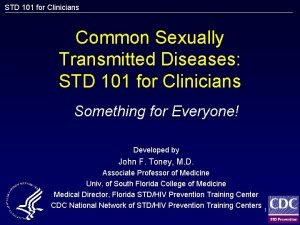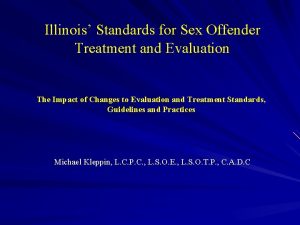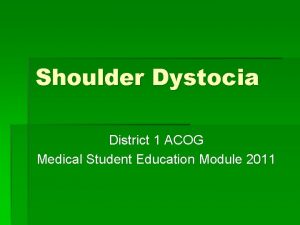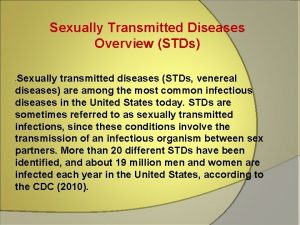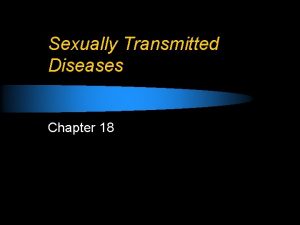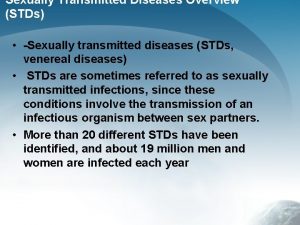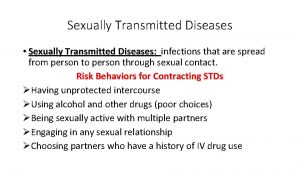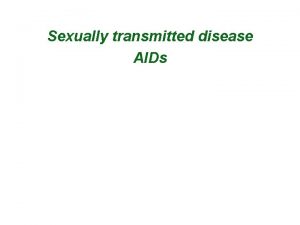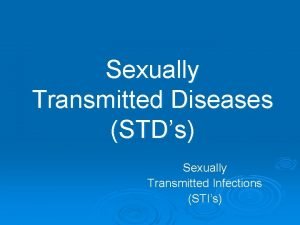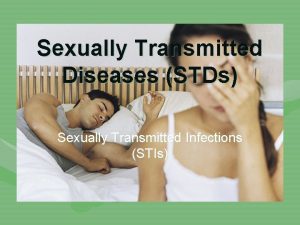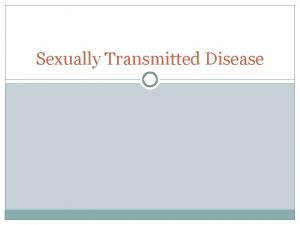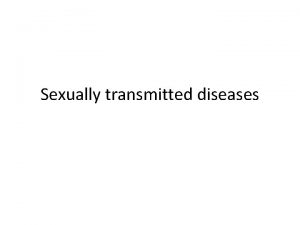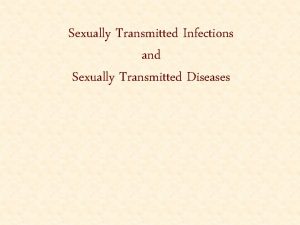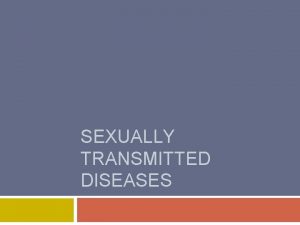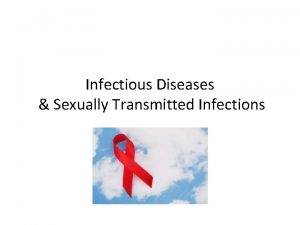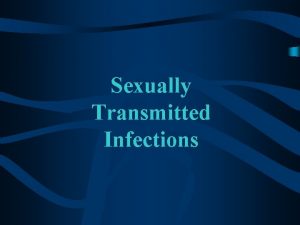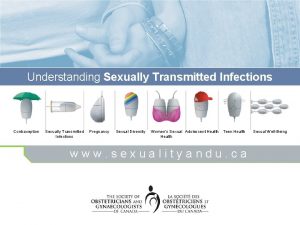Sexually Transmitted Diseases 3 rd Medical Students Prof



































- Slides: 35

Sexually Transmitted Diseases 3 rd Medical Students Prof. Dr. Asem Shehabi Faculty of Medicine, University of Jordan

Introduction § More than 1 million people acquire a sexually transmitted infection (STI) every day. § Each year, an estimated 500 million people become ill with one of 4 STIs: Chlamydia, gonorrhoea, syphilis and trichomoniasis. § More than 530 million people have the virus that causes genital herpes (HSV 2). § More than 290 million women have a human papillomavirus (HPV) infection. § The majority of STIs are present without symptoms.

2/ § STIs can have serious complications beyond the immediate impact of the infection itself, through mother -to-child transmission of infections and chronic diseases. § Drug resistance, especially for gonorrhoea, is a major threat to reducing the rate STIs worldwide. § STIs are caused by more than 30 different bacteria, viruses and parasites and are spread predominantly by sexual contact, including vaginal, anal and oral sex. § Many STIs—including chlamydia, gonorrhoea, hepatitis B, HIV, HPV, HSV 2 and syphilis—can also be transmitted from mother to child during pregnancy and childbirth

World Map STDs

Common Bacterial & Fungal Agents of STDs § Neisseria gonorrhea: Gonorrhea § Chlamydia trachomatis, Mycoplasma genitalium /Ureaplasma urealyticum. . causing nonspecific urethritis, vaginitis, salpengitis, pelvic inflammatory disease by one or more organisms. § Treponema pallidum : Syphilis § Haemophilus ducryi : Chancroid § Gardenella vaginatis : Vaginoses, Mixed bacteria infection § Candida spp. : Vaginitis

Gonorrhea § N. gonorrheae. . Gram-negative diplococci , killed rapidly outside human host. Presence pili & surface cell outmembrane proteins support cells attachment, infect & cause local inflammation of mucosa genital tract, throat, rectum both men and women. . Acute & chronic stages. § In women: vagina & cervix are the first infected. . infection can spread into the uterus & fallopian tubes, resulting in Pelvic Inflammatory Disease (PID)/ endometritis and salpengitis. . § Common complication: Ectopic pregnancy & infertility in about 10% of chronic infected women. § New born eye-infection is common in asymptomatic infected mother. . Ophthalmia neonatorum. . causes cornea damage & blindness without treatment.

Neisseria Gram-ve diplococci

SYMPTOMS § § Infection in women: Mostly first mild without symptoms (80%). . bleeding can be associated with vaginal intercourse. . Later chronic infection. . painful burning sensations during urinating, occasionally yellow or bloody purulent vaginal discharge. § Infection in men: Develop mostly as acute urethritis with symptoms more often than women including: fever, burning sensations, abdominal pain. Urethral discharge/ white/ yellow pus with mild to severe pain. . anal infection & itching. Incub. period 2 -10 days. § Disseminated N. gonorrhea may cause epididymitis, prostitis / orchitis & infertility. . Complications: Rarely blood sepsis, meningitis, endocarditis, dermatitisarthritis syndrome.

DIAGNOSIS & TREAMENT § Direct Gram-Stain smear from urethral/vaginal discharge , presence intracellular Gram-negative diplococci resembling Neisseria in polymorphonuclear leukocytes. § Rapid culture of specimens-discharge-cervical swabs, rectal swab /throat. . Blood/ Chocolate agar (Thayer. Martin blood agar includes certain antibiotics), 24 -48 hrs, microaerophlic incubation, biochemical sugar test & +ve oxidase & catalase. § Antimicrobial drugs. . mostly R-penicillin, Relatively Effective drugs Cefixime, Ceftriaxone, Ciprofloxacin, Doxycycline. . susceptibility test should be done. § No immunity after infection. . No vaccine is available

Syphilis § § § T. pallidum has a characteristic helical/Spiral shape. . 4 -15 um. . Related to Gram-negative bacteria. . can’t demonstrated by Gram-stain. Treponema cell wall contains peptidoglycan layer rich in Lipids & Endoflagella within outer membrane. . Responsible for motility. Treponema cells are very sensitive to drying, heat and disinfectant. . survive few minutes outside the human body. . Infect only human host. Pathogenicity: Hyaluronidase, high lipids enhance invasiveness , contributes to granulomatous lesions & autoimmune reaction during progressive infection. Can’t be cultured in vitro, but it can be isolated in Rabbit testicles for research.

Morphology of Treponema

General Feature § Transmission: Sexual contact, blood, body fluids of infected person. § Bacteria pass infected skin or mucous membranes usually of genital area, lips, mouth, anus. § Treponema active cells penetrate and reside in epithelial cells. . multiply slowly. . 2 -6 Weeks § Syphilis has so many clinical symptoms § Presence HIV infection at the same time can change the symptoms and course of syphilis. § Syphilis other than congenital syphilis, occurs in 3 -4 stages that sometimes overlap over many years.

Primary Syphilis-1 § Primary syphilis is often a small, round firm , painless ulcer /chancre/ lesion. . Highly infectious § Most lesions appears on Extra Skin Genitalia / Vagina, but ulcers can also develop on the cervix, tongue, lips, or other parts of the body. . can be easily overlooked without symptoms. . No fever. § There is often only one ulcer. . nearby swollen lymph nodes. . The ulcer usually appears about 3 weeks after infection, but it can occur any time within 3 months after exposure to infection & disappears after 4 weeks .

Secondary syphilis-2 § If primary syphilis is not treated. . mostly progress to the Secondary stage. § Most persons with secondary syphilis have red maculopapular skin rash. . including often palms of hands and soles of feet. . Associated with moist lesions. . Candylomas which occur in the anal or genital areas as a flat soft lesions. § Other common symptoms include: Sore throat, fatigue, headache, swollen lymph glands. Less frequent symptoms include fever, hepatitis, meningitis, glomerulonephritis, weight loss, hair loss, lesions (cold sores) in the mouth or genital area. § Most lesions of secondary syphilis contain many Active Treponema. . Patients is highly infectious.

Diffuse skin rash associated with Syphilis

Congenital Syphilis § Pregnant woman with secondary syphilis may infect fetus vertically in utero during first trimester & at birth. . Infection may cause miscarriage, premature babies & stillbirth. § Few percentage of infants with Congenital syphilis have symptoms at birth. . but the majority develop symptoms later. . After 2 years. § Untreated babies may have facial & tooth deformities. . delays in growth or seizures along with many other problems such as rash, fever, swollen liver and spleen, jaundice, anemia, including damage to their bones, teeth, eyes, ears, brain.

Latent/Tertiary Syphilis-3 § As with primary syphilis. . secondary syphilis will disappear even without treatment. . infection will progress to the next hidden stages. § latent syphilis: Positive blood syphilis test. . often without clinical signs or symptoms. . Rare transmission of Infection. . Without treatment will progress slowly over many years to Tertiary syphilis § During this stage antibodies, cell-mediated immunity, hypersensitivity developed to Treponema antigens. . play a role in immunity. . But not sufficient to stop the development of disease complication in each case. § Few % infected people develop Tertiary Syphilis

Tertiary syphilis-4 § Tertiary Syphilis is autoimmune reaction to Treponema antigens. . Which damages heart, eyes, brain, nervous system, bones, joints. . almost any other part of body by developing Gummas. § Gummatos syphlilis. . progressive destructive granulomatous lesions over many years. . Mostly skin, bones, Liver, mucocutaneous tissues. . Lesions are free of Treponema. . Noninfectious. . High mortality. § Neurosyphilis. . meningovascular syphilis. . associated with degenerative CNS. . brain or spinal cord damage. . is one of the most severe signs of this stage. . Paralysis and Death Cardiovascular syphilis. . affects heart muscles. . causing fatal aortic aneurysm.

Non-sexually transmitted Treponema § Pinta-Yaws. . both are contagious, non-venereal infection caused by T. pertenue, T. carateum § Human infection occurs mainly in children less than 15 years. . Following direct skin to skin contact with infected person. . causing depigmention skin lesions in legs, finger, face, chest, abdomen. . § The disease occurs primarily in warm, humid, tropical subtropical areas of Africa, Asia, South America. § Bejel is non-venereal syphilis-like disease. . called endemic Syphilis caused by T. endemicum. § Transmission. . Direct contact. . First soft oral & skin lesion in face, later may affect Nasopharynx and bones. . Diagnosis & Treatment similar to Syphilis.

Lab Diagnosis-1 § It is very difficult to diagnose syphilis based on clinical symptoms without the presence of the first genital ulceration or skin rash. § Symptoms and signs of the disease might be absent. . or be confused with those of other diseases. § Direct Dark Field Microscopy can detect Treponema spiral forms and motility from fresh collected exudateslesions § T. pallidum can’t be observed in Gram-stain. . Sliverstain can be used in biopsy. . No Culture in vitro

Lab Diagnosis-2 § Serology Screening Tests. . Non-Specific tests: 1 -VDRL – Venereal Disease Research Laboratory. 2 -RPR – Rapid Plasma Reagin. . Both used antigens include Cardiolipin + cholesterol+ Lecihthin § Both detect anti-lipid Ig. G & Ig. M in host Serum after infection 2 -4 weeks. . After disappear the skin lesions ( Primary / Secondary Syphilis). § Both tests become negative after antibiotic treatment and in Tertiary Syphilis. § The test may give positive results with other diseases. . Collagen vascular disease, Acute febrile disease, Recent bacterial vaccination.

Specific Confirmatory Tests § Fluorescent Treponemal Antibody Absorption- FTAABS test. . (Killed Treponema cells +Patients serum+ Labeled antihuman gamma globulin). . Detects presence of Ig. G & Ig. M in Serum & CSF. . High specific and sensitive for all stages. § T. pallidum Microhemagglutination Assay detects syphilis antigens. . specific and sensitive. . confirm most stages of infection § All tests can’t distinguish Syphilis from other nonsexually transmitted Treponema infections. . Yaws & Pinta, Bejel.

Treatment & Prevention-1 § Syphilis is easy to cure in its early stages. . Intravavenous Penicillin is the best treatment for syphilis. § Doxycycline can be given. . For Penicillin allergic persons. § Always both partners should be treated § Late syphilis. . Cann’t be reversed. . Untreated syphilis in women cause miscarriages. . premature births, stillbirths, or death. . No Vaccine is available

Chlamydia trachomatis-1 § C. trachomatis is one of the most widespread bacterial of STDs. . About 50 Million of new cases each year worldwide. . Human natural host, Genital serotypes. . Intracellular Growth. . Elementary bodies. . Infectious stage, Reticulate bodies replicate in infected mucosal tissue as inclusion bodies. § Chlamydial infection followed vaginal/anal sexual contact with an infected partner. . Sexual Infection is more asymptomatic in women than men (80%). . Incub. 1 -3 weeks. § In men, most early symptoms are mild, few pus cells- dysuria, nonspecific ureithritis. . Non-treated infection may progress slowly over years to cause epidydimitis, prostitis, proctitis & Infertility.

Chlamydia Elementary- and Reticulate bodies


Chlamydia symptoms-2 § In women infection causes cervicitis, urethritis, Proctitis, endometritis, salpingitis. . pelvic inflammatory disease (PID). . Pelvic adhesion & Infertility. § Newborn baby may be infected during delivery. . develop eye infection. . inclusion conjunctivitis. . Ophthalmia neonatorum. § Symptoms of conjunctivitis, which include discharge and swollen eyelids, usually develop within the first 10 days of life. § Complication: Trachoma, Blindness. . Rarely cause Neonatal atypical pneumonia. § Adult infection inclusion conjunctivitis due to spread from genitalia to eye by contaminated fingers.

Chlamydia diagnosis-3 § Detection Chlamydia Plasmid/DNA in urine/cervical swabs/ urethral swabs by PCR test. § Elementary bodies of Chlamydia can be identified by direct smear prepared from discharge. . stain with monoclonal antibodies, detected by florescence microscopy by Direct immunofluresent test. § Chlamydia antigen test is a rapid test detect the Chlamydia antigen from female cervical swab, male urethral. Ma. Coy cell tissue culture used for isolation & antibiotic susceptibility § Serological test is not significant for detection genital infection.

Chlamydia -4 § Chlamydia is easily confused with gonorrhea in women because the symptoms of both diseases are similar and both diseases may occur together. § Lymphogranuloma venerum. . C. trachomatis. . serotypes L 1 -L 3. . Common in tropical countries. . Infection starts as genital ulcer with Lymphadenopathy. . spread to genitourinary and gastrointestinal tract. . causing inflammation & strictures in genital tract. § Treatment: Doxycycline. . Erythromycin § No vaccine

Other genital Infections § Mycoplasma genitalium/ M. hominis, Ureaplasma urealyticum: These can be present without any symptoms in about 20% genital tract males/females. . Single or more organisms may cause up to 25% cases of non-specific urethritis. . mostly M. gentitalium in men. . Mild discharge few pus cells, burning and pain during urinating. § In women, cases of mucopurluent cervicitis & PID can be associated with M. hominis/ M. gentitalium § Vaginitis inflammation vagina result in discharge, itching, burning, pain due to change in the normal balance of vaginal bacteria. . reduced lactobacilli or estrogen levels after menopause. . Also associated with Candida spp. or mixed infection.

Vaginitis-2 § Bacterial vaginosis (BV). . Mixed bacteria is the most common cause of vaginitis. § Gardnerella vaginalis: Part of vaginal flora. . may cause in association with anaerobic or other bacteria vaginosis. § Diagnosis: Direct Gram-stain. . presence of numerous "clue cells" (cells from the vaginal lining. . coated with numerous gram-variable bacteria, pus cells & fishy odor. . Culture urine / cervical swabs § Vaginitis treatment of Mycoplasma : Doxycycline. . Erythromycin § Vaginosis treatment: metronidazole or clindamycin

YEAST INFECTION § Vaginal yeast infection, or vulvovaginal candidiasis, is a common cause of vaginal irritation. . discharge § This common fungal infection occurs when there is an increase in presence of one or more Candida albicans or others C. glabrata, C. tropicals, C. krusei § Although this infection is not considered an STI, 10 to 15 percent of men/women develop symptoms after sexual contact with an infected partner. § Candida spp. are always present in the vagina in small numbers. . Several factors are associated with increased yeast infection in women, including:

Candida albicans Pseudohyphae

Yeast infection-2 § Pregnancy, using oral contraceptives , using steroid drugs/ antibiotics, having uncontrolled diabetes mellitus. § Wearing tight, poorly ventilated clothing and synthetic underwear may contribute to vaginitis. § The most frequent symptoms of yeast infection in women are itching, burning, and irritation of the vagina. Painful urination are common. § Vaginal discharge is not always present and may be a small amount. The thick, whitish-gray discharge is typically. . it can vary from watery to thick discharge. § Repeat occurrence vaginal candidasis is very common.

Yeast infection- 4 Diagnosis & Treatment § Microscopic examination of discharge/urine Presence of numerous yeast cells. . Pseudohyphae. § Culture on Sabouraud Dextrose Agar, Chrom. Candida Agar, Serum Germ Tube test. § Various antifungal vaginal drugs are available to treat yeast infections. § Antifungal creams can be applied directly to the area. . oral or vaginal cream of fluoconazole, miconazole, clotrimazole.
 Chapter 24 lesson 1 sexually transmitted diseases
Chapter 24 lesson 1 sexually transmitted diseases Chapter 24 sexually transmitted diseases and hiv/aids
Chapter 24 sexually transmitted diseases and hiv/aids Std
Std Nursing management of reproductive tract infection
Nursing management of reproductive tract infection A bacterial std that usually affects mucous membranes
A bacterial std that usually affects mucous membranes Sexually transmitted disease
Sexually transmitted disease How do whales reproduce sexually
How do whales reproduce sexually Platyhelminthes examples
Platyhelminthes examples Spider phylum
Spider phylum What is sexually dimorphic mean
What is sexually dimorphic mean Sexual coercion definition
Sexual coercion definition Reproduction in protists
Reproduction in protists Was i sexually abused as a child quiz
Was i sexually abused as a child quiz Sea daisy class
Sea daisy class Chrysophta
Chrysophta Arousal hormones
Arousal hormones How do annelids reproduce
How do annelids reproduce Sexual harassment true or false quiz
Sexual harassment true or false quiz Atis sexually or asexually
Atis sexually or asexually Class aves
Class aves Do jellyfish reproduce sexually
Do jellyfish reproduce sexually Frustrated freight meaning
Frustrated freight meaning Spongia officinalis
Spongia officinalis How birds mate
How birds mate Dimorphism meaning
Dimorphism meaning Sexually dangerous persons act illinois
Sexually dangerous persons act illinois Rizal participated in the student demonstration in madrid
Rizal participated in the student demonstration in madrid Transmitted light examination in questioned document
Transmitted light examination in questioned document A song transmitted orally which tell a story
A song transmitted orally which tell a story Which theory is used to determine safe design of bearings?
Which theory is used to determine safe design of bearings? Electronically transmitted postal ballot system
Electronically transmitted postal ballot system The totality of learned socially transmitted behavior
The totality of learned socially transmitted behavior Helper in shoulder dystocia
Helper in shoulder dystocia Psychology lecture for medical students
Psychology lecture for medical students Pathology lectures for medical students
Pathology lectures for medical students California medical license application
California medical license application





